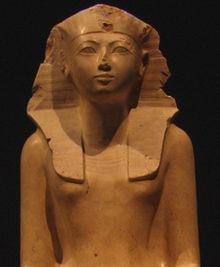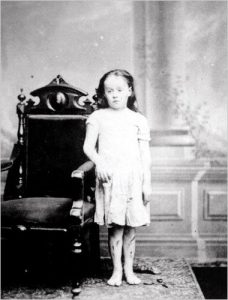Winner of the Fall 2016 StMU History Media Award for
Best Introductory Paragraph
Article with the Best Title
Queen B said it best when she sang the infamous line, “Who run the world? Girls.”1 When looking back to history, men are seen as better and treated better than women. A long time ago, in ancient Egypt, women of the royal family served as guides to young male rulers. But there was one unconventional case where a woman defied the odds and obtained the role of pharaoh.

Queen Hatshepsut was the oldest daughter of Thutmose and his Great Royal Wife, Queen Ahmose. Thutmose, like most males who held power during those times, had another wife with whom he had a son. His name was Thutmose II; when he was at the age of eight and Hatshepsut was thirteen, they were wed, despite the fact of their shared blood line. When their father passed, Thutmose II assumed the position of pharaoh. While he was pharaoh, they birthed a daughter, but every male in power needs a male heir. Since she was unable to produce a son, he and a minor wife, Iris, conceived a son who became Thutmose III. Thutmose II and Hatshepsut reigned in Egypt until his death. The next male in line was Thutmose III, but Hatshepsut’s step child was too young to fulfill the position of pharaoh, so she ruled in his stead. On that note, even when he did become old enough to rule, she refused to turn over the power to him, and she remained in power. That is when she began her transition from Queen Hatshepsut to Pharaoh Hatshepsut.2

The Queen herself had a headdress made that included a beard and some male characteristics.3 She did not go out of her way to keep her gender a secret, for she did include feminine touches to her attire. Masculinity of course was respected more and was associated with power, which is why she sometimes took on such characteristics. Despite being a female ruler, at that time (and still today) people would not expect such a flourishing reign. Beginning in 1473 B.C.E. and ending in 1458 B.C.E., under her control wealth was accumulated. When it came to the protection of Egypt, she engaged in successful warfare against her invaders. She also had an extensive building program in which a temple of devotion to their sun god, Amun, was erected. Prosperity and wealth also came about because she sent ships on expeditions to foreign lands to obtain riches. These included ivory, ebony, gold, and trees. Now, why would they bring back trees? Whenever they had temple ceremonies, trees would be burned by the tons for fragrant incense.4
All good things must come to an end, and this particular ending is death. After she died, successors attempted to erase the fact that a female had become pharaoh.5 Even with this attempt to erase history, she is still known as a successful pharaoh to this day. She brought about protection, prosperity, and plenitude during her time as king. She did not serve as a guide to a young male pharaoh, but she showed how one must rule during her reign.
- Beyoncé, “Run the World (Girls),” in 4, Columbia Records, 2011. ↵
- Ann Macy Roth, “Models of Authority: Hatshepsut’s Predecessors in Power,” in Hatshepsut: From Queen to Pharaoh, ed. Catharine H. Roehrig, Renee Dreyfus, and Cathleen A. Keller (New York: Metropolitan Museum of Art, 2005), 10. ↵
- Roth, “Models of Authority: Hatshepsut’s Predecessors in Power,” 10. ↵
- Rupert Matthews, DK Eyewitness Books: Explorer (DK Publishing, 2012), 8. ↵
- Angela Murock Hussein, “Legacy of a Female Pharaoh,” Calliope 19, no. 1 (September 2008): 48. ↵



85 comments
Amanda Gutierrez
Interesting article! Queen Hatshepsut is always an intriguing topic. I loved your introduction with starting the article with a Beyonce reference as it catches the readers’ attention. With the numerous male names one could find in a World History textbook, it is refreshing to read a story such as Hatshepsut’s. She was truly one of the greatest rulers of her time. Overall, this was a well-executed article! Nice job!
Mia Hernandez
The introduction to this article was amazing! Queen B always catches my attention but Queen Hatshepsut had me intrigued with her ruling. This article showed how strong women really are. Queen Hatshepsut demonstrated that woman can do a task just as good or even better than a male. I can not believe that they tried to get rid of any evidence that showed her as ruler. I do not understand why they weren’t just as proud of her as they would have been if it was a male ruler. I had never heard of a female ruler in Egypt and I think it was a good surprise.
Micheala Whitfield
Women will always be the backbone or the creator of something successful. Great article and the way it was written. You told the story of her life. I really wish I could have read more about the things she did during her reign. That was a long reign and no one over threw her or even tried to kill her. Well probably didn’t succeed that is. What I think is hilarious is the fact they tried to get ride of the evidence of such a ruler. Just because she is female. Female are incredibly powerful and in Egypt you don’t get to see that very often. Awesome story.
Kasandra Ramirez Ferrer
This is really an amazing story and I liked it a lot, I thought the idea of a woman being an Egyptian emperor was impossible since Egyptian culture was extremely strict and traditions had to be followed. There is no doubt that pharaoh Hatshepsut brought wealth and prosperity to the empire in her reign until she died, it’s no surprise that after her death people tried to erase everything she did and the fact there was a female pharaoh. However, the power and influenced cold not been erased by others since now is known Pharaoh Hatshepsut existed and was a great ruler.
Andrea Degollado
Very well written article! This article was truly amazing to read. Queen Hatshepsut really demonstrated that women can achieve anything, she is undeniably one of the greatest rulers of all time. I loved the Beyonce reliance! I think it was so interesting to read how she put a beard on to seem more dominant and powerful to the public, This was a great article! good job!
Victoria Muller
This was a nice article to read, I had never known or heard of a single female pharaoh until now. I really like how even though masculinity was associated with power she didn’t hide the fact that she was a female ruler. It’s even more impressive to find out that even though her successors tried to hide that she had become a pharaoh, history carried on and we are able to learn about her and her leadership today.
Vania Gonzalez
All throughout history women are thought of as less capable than a man but in most cases there is always a woman who pulls the strings from behind. Most influential women are the whispers in their husbands ears but some end up being the main minds behind the success just like Pharaoh Hatshepsut; in Egypt women were already a sort of guide so they had some authority over the empires affairs. Women are more capable than society believes and they always end up being the most successful than the men in their society.
D'Hannah Duran
Queen Hatshepsut changed the idea that only men were able to lead, by not being scared to show her gender she was able to show everyone that a woman was able to lead. It is a shame that they had tried to cover up her rule when they could have applauded her reign. She was able to prove that women can do equal to that of a man and even do more then believed which is amazing for that time.
Kristina Tijerina
I love this article for the fact that it is true, men held more power than women did, but Hatshepsut defied all odds. Her becoming Pharaoh and ruling as a successful leader is amazing to hear especially during this time. During this time many men and women were praised for beauty, but only men held a respectable amount of power. The fact that Hatshepsut included male characteristics in her headdress, but also never kept her femininity a secret is inspiring to read about. It shows that women are at the same level as men are. Women can and should be respected as equally as men. It’s also sad that after Hatshepsut’s death, successors tried to erase that fact that a woman was ever Pharaoh. However, she is still well known to this day, and that’s super cool.
Tala Owens
This is so amazing especially during a time where men are seen as incredibly superior. It’s sad that they tried to cover up her legacy because she had such a great one that brought in wealth and lots of resources. I’m glad she didnt give up her position and remained in power until she became a pharaoh. She was truly making history.